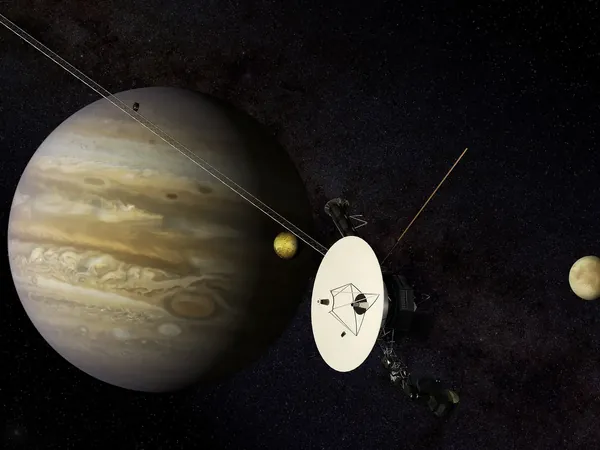
Voyager 2's Voyage Through the Cosmic Unknown: Questions That Baffle Scientists!
2025-09-01
Author: Mei
NASA's Voyager 2, launched in 1977 to investigate the outer planets, has incredible news: it’s now journeying through the vastness of interstellar space! In November 2018, this remarkable spacecraft became the second human-made object to break through the heliosphere’s outer boundary—a vast bubble of particles and energy created by our Sun. However, its groundbreaking discoveries have sparked more questions than answers.
A Surprising Transition Beyond the Solar Winds!
As Voyager 2 crossed the heliopause, approximately 18 billion kilometers from Earth, scientists expected a dramatic shift in the environment. To their astonishment, the transition was anything but obvious. Instead of encountering stark differences in magnetic fields and particle density, Voyager detected only faint variations, leaving experts scratching their heads about the mysteries of this cosmic frontier.
Magnetic Mysteries: Aligned Against Expectations!
Further complicating matters, Voyager 2 confirmed what its sibling, Voyager 1, had previously observed: the magnetic field outside the heliosphere aligns similarly to that of the interior. This revelation caught many scientists off guard, as it was widely believed that interstellar space would present a drastically different magnetic orientation. Decoding the reasons behind this unexpected alignment remains one of the most tantalizing challenges in heliophysics.
Voyager Takes on Cosmic Ray Invasion!
In the uncharted territories beyond the heliosphere, both Voyager spacecraft recorded a sharp surge in galactic cosmic rays—high-energy particles racing in from the far reaches of our galaxy. The heliosphere seemingly acts as a protective barrier against this radiation; however, the precise mechanics of how this shield functions and fluctuates over time are still shrouded in mystery. These insights are critical for our understanding of potential cosmic hazards for future interstellar travelers.
Not Your Average Sphere: The Heliosphere's Shape!
Interestingly, Voyager 1 and Voyager 2 exited the heliosphere from different points, pointing to a non-uniform, distorted shape of this protective bubble. This distortion could be influenced by the Solar System's journey through the galaxy or interaction with interstellar materials. Figuring out the true structure of the heliosphere is an ongoing puzzle for scientists.
The Future of the Heliosphere: Evolution or Disintegration?
Equally intriguing is the question surrounding the longevity of our heliosphere. Data from Voyager 2 could provide crucial clues about how this protective region evolves and its future collapse as our Sun ages and its solar winds weaken. Grasping these dynamics is vital for anticipating the habitability of our planetary system in the eons to come.
A Journey Beyond the Known!
Currently speeding through the cosmos at over 55,000 kilometers per hour, Voyager 2 is expected to continue transmitting data until around 2030, when it will finally go silent. By that time, it will have traveled further than any spacecraft except its twin, Voyager 1. Yet, it’s the cascade of questions about magnetic fields, cosmic rays, and the heliosphere's shape that ensures Voyager 2's mission remains one of the most captivating in the annals of space exploration!

 Brasil (PT)
Brasil (PT)
 Canada (EN)
Canada (EN)
 Chile (ES)
Chile (ES)
 Česko (CS)
Česko (CS)
 대한민국 (KO)
대한민국 (KO)
 España (ES)
España (ES)
 France (FR)
France (FR)
 Hong Kong (EN)
Hong Kong (EN)
 Italia (IT)
Italia (IT)
 日本 (JA)
日本 (JA)
 Magyarország (HU)
Magyarország (HU)
 Norge (NO)
Norge (NO)
 Polska (PL)
Polska (PL)
 Schweiz (DE)
Schweiz (DE)
 Singapore (EN)
Singapore (EN)
 Sverige (SV)
Sverige (SV)
 Suomi (FI)
Suomi (FI)
 Türkiye (TR)
Türkiye (TR)
 الإمارات العربية المتحدة (AR)
الإمارات العربية المتحدة (AR)